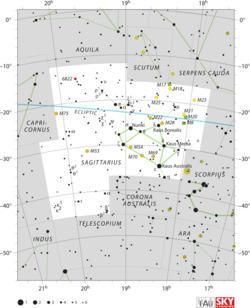Astronomy:Rho2 Sagittarii
From HandWiki
Short description: Star in the constellation Sagittarius
| Observation data Equinox J2000.0]] (ICRS) | |
|---|---|
| Constellation | Sagittarius |
| Right ascension | 19h 21m 50.89574s[1] |
| Declination | −18° 18′ 30.1996″[1] |
| Apparent magnitude (V) | +5.87[2] |
| Characteristics | |
| Spectral type | K0 III[3] |
| B−V color index | +1.06[2] |
| Astrometry | |
| Radial velocity (Rv) | −12.7±2.9[4] km/s |
| Proper motion (μ) | RA: +102.72[1] mas/yr Dec.: −93.20[1] mas/yr |
| Parallax (π) | 9.82 ± 0.40[1] mas |
| Distance | 330 ± 10 ly (102 ± 4 pc) |
| Absolute magnitude (MV) | +0.80[5] |
| Details | |
| Luminosity | 60.4[6] L☉ |
| Temperature | 4,721[6] K |
| Other designations | |
| Database references | |
| SIMBAD | data |
Rho2 Sagittarii (ρ2 Sagittarii) is a star in the zodiac constellation of Sagittarius. With an apparent visual magnitude of +5.87,[2] it is near the lower limit of stars that can be seen with the naked eye. Based upon an annual parallax shift of 9.82 mas as seen from Earth,[1] it is located around 330 light years from the Sun.
This is an evolved K-type giant star with a stellar classification of K0 III.[3] As a result of a 1997 lunar occultation, a companion star was discovered at an angular separation of 21 mas. It appears to be an A-type main sequence star with a class of around A5. This companion was not detected during prior occultations by the Moon.[8]
References
- ↑ 1.0 1.1 1.2 1.3 1.4 1.5 van Leeuwen, F. (2007), "Validation of the new Hipparcos reduction", Astronomy and Astrophysics 474 (2): 653–664, doi:10.1051/0004-6361:20078357, Bibcode: 2007A&A...474..653V.
- ↑ 2.0 2.1 2.2 Corben, P. M.; Stoy, R. H. (1968), "Photoelectric Magnitudes and Colours for Bright Southern Stars", Monthly Notes of the Astronomical Society of Southern Africa 27: 11, Bibcode: 1968MNSSA..27...11C.
- ↑ 3.0 3.1 Houk, Nancy; Smith-Moore, M. (1978), Michigan catalogue of two-dimensional spectral types for the HD stars, 4, Ann Arbor: Dept. of Astronomy, University of Michigan, Bibcode: 1988mcts.book.....H.
- ↑ Gontcharov, G. A. (2006), "Pulkovo Compilation of Radial Velocities for 35 495 Hipparcos stars in a common system", Astronomy Letters 32 (11): 759–771, doi:10.1134/S1063773706110065, Bibcode: 2006AstL...32..759G.
- ↑ Anderson, E.; Francis, Ch. (2012), "XHIP: An extended hipparcos compilation", Astronomy Letters 38 (5): 331, doi:10.1134/S1063773712050015, Bibcode: 2012AstL...38..331A.
- ↑ 6.0 6.1 McDonald, I. et al. (2012), "Fundamental Parameters and Infrared Excesses of Hipparcos Stars", Monthly Notices of the Royal Astronomical Society 427 (1): 343–57, doi:10.1111/j.1365-2966.2012.21873.x, Bibcode: 2012MNRAS.427..343M.
- ↑ "rho02 Sgr". SIMBAD. Centre de données astronomiques de Strasbourg. http://simbad.u-strasbg.fr/simbad/sim-basic?Ident=rho02+Sgr.
- ↑ Richichi, A. et al. (October 1999), "New binary stars discovered by lunar occultations. IV", Astronomy and Astrophysics 350: 491–496, Bibcode: 1999A&A...350..491R.
 |


